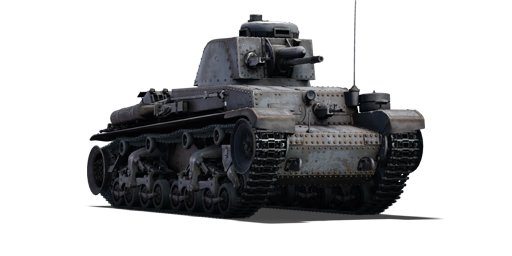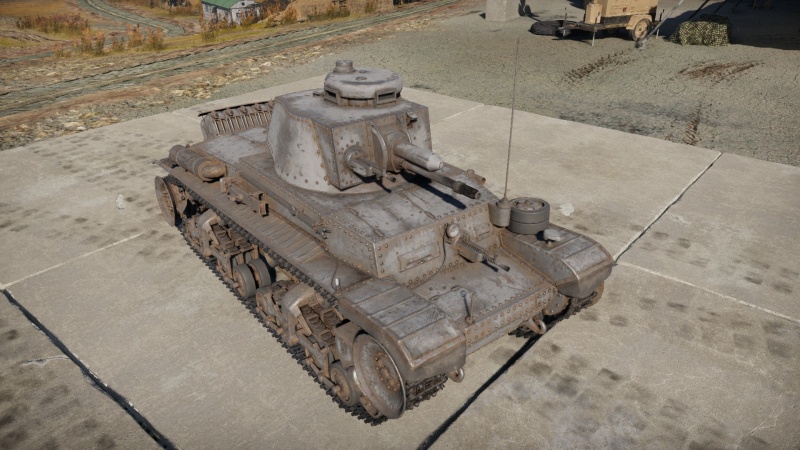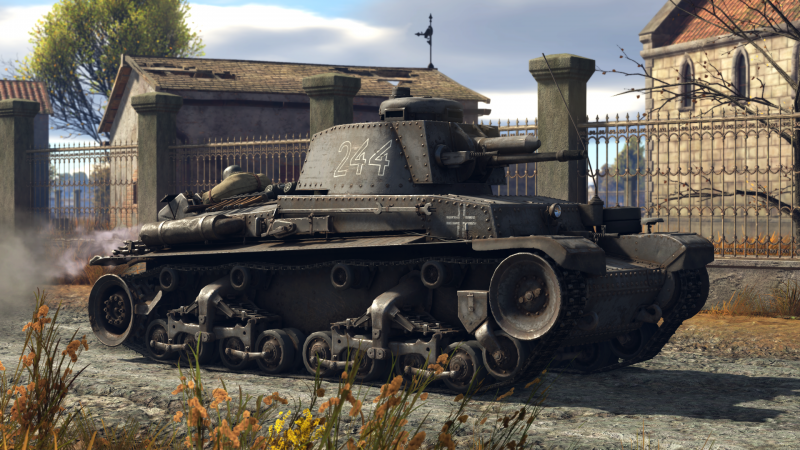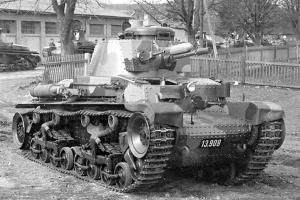Pz.35(t)
Contents
Description
The Pz.Kpfw. 35(t) is a rank I German light tank with a battle rating of 1.0 (AB/RB/SB). It was introduced in Update 1.51 "Cold Steel".
General info
Survivability and armour
Armour type:
- Rolled homogeneous armour
- Cast homogeneous armour (Cupola)
| Armour | Front (Slope angle) | Sides | Rear | Roof |
|---|---|---|---|---|
| Hull | 25 mm (18°) Front plate 16 mm (80°) Front glacis 25 mm (31°) Lower glacis |
16 mm | 16 mm | 12 mm |
| Turret | 25 mm (10°)Turret front 25 mm Gun mantlet |
16 mm | 16 mm | 8 mm |
| Cupola | 25 mm (cylindrical) | 25 mm (4°) | ||
Notes:
- Suspension wheels and tracks are 15 mm thick while and torsion bars are 8 mm thick.
- The belly is 8 mm thick.
- Mudguards and fuel cans are 4 mm thick.
The Pz.35(t) has a key advantage over most low battle rated tanks which is found also on French tanks - it has 25 mm front armour on the hull and turret which makes it immune to 12.7 mm machine guns that are commonplace at its tier, however, the sides can be penetrated with such weapons. It has four crew with decent spacing between them, but a far cry from the Panzer III/IV, so while it can save you sometimes, don't rely on it, especially if a Soviet APBC or British 2-pdr shell is coming your way.
Mobility
| Game Mode | Max Speed (km/h) | Weight (tons) | Engine power (horsepower) | Power-to-weight ratio (hp/ton) | |||
|---|---|---|---|---|---|---|---|
| Forward | Reverse | Stock | Upgraded | Stock | Upgraded | ||
| Arcade | 38 | 38 | 10.5 | 186 | 229 | 17.71 | 21.81 |
| Realistic | 34 | 34 | 106 | 120 | 10.1 | 11.43 | |
With a top speed of 33 km/h and a power-to-weight ratio of 11.43 hp/ton in Realistic and Simulator battles, the Pz.35(t) has reasonably good mobility for a reserve tank. With a top speed almost 20 km/h faster than yours, Stuart and BT tanks are notable enemies as they will flank you quickly.
Modifications and economy
Armaments
Main armament
| 37 mm KwK34(t) | Turret rotation speed (°/s) | Reloading rate (seconds) | |||||||||||
|---|---|---|---|---|---|---|---|---|---|---|---|---|---|
| Mode | Capacity | Vertical | Horizontal | Stabilizer | Stock | Upgraded | Full | Expert | Aced | Stock | Full | Expert | Aced |
| Arcade | 72 | -10°/+25° | ±180° | Vertical | 13.3 | 18.5 | 22.4 | 24.8 | 26.4 | 4.29 | 3.80 | 3.50 | 3.30 |
| Realistic | 8.3 | 9.8 | 11.9 | 13.2 | 14.0 | ||||||||
The Pz.35(t) is armed with the 37 mm KwK 34(t), which has an APC shell with 55 mm pen and a Tier I unlockable APC shell with 52 mm pen. It also possesses an 85 mm penetration APCR shell for more heavily armoured targets such as B1 bis.
Ammunition
| Penetration statistics | |||||||
|---|---|---|---|---|---|---|---|
| Ammunition | Type of warhead |
Penetration @ 0° Angle of Attack (mm) | |||||
| 10 m | 100 m | 500 m | 1,000 m | 1,500 m | 2,000 m | ||
| Pzgr. 34(t) | APC | 55 | 51 | 39 | 28 | 20 | 15 |
| PzGr. 40 | APCR | 81 | 73 | 45 | 24 | 13 | 7 |
| Pzgr.(t) umg. | APC | 53 | 50 | 37 | 26 | 19 | 13 |
| Shell details | ||||||||||||
|---|---|---|---|---|---|---|---|---|---|---|---|---|
| Ammunition | Type of warhead |
Velocity (m/s) |
Projectile mass (kg) |
Fuse delay (m) |
Fuse sensitivity (mm) |
Explosive mass (TNT equivalent) (g) |
Ricochet | |||||
| 0% | 50% | 100% | ||||||||||
| Pzgr. 34(t) | APC | 675 | 0.85 | 1.2 | 9 | 22.1 | 48° | 63° | 71° | |||
| PzGr. 40 | APCR | 980 | 0.37 | - | - | - | 66° | 70° | 72° | |||
| Pzgr.(t) umg. | APC | 675 | 0.82 | 1.2 | 9 | 22.1 | 48° | 63° | 71° | |||
Note: The PzGr. 34(t) round has no tracer.
Ammo racks
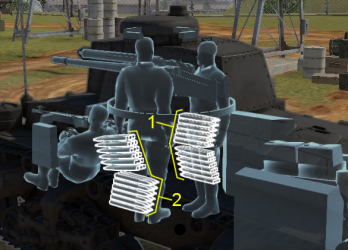
| Full ammo |
1st rack empty |
2nd rack empty |
Visual discrepancy |
|---|---|---|---|
| 72 | 37 (+35) | 1 (+71) | No |
Notes:
- Racks disappear after you've fired all shells in the rack.
- To go into battle with the right flank empty of ammo, pack 37 (+35) shells (rack 1 emptied).
Machine guns
| 7.92 mm MG37(t) | ||||
|---|---|---|---|---|
| Mount | Capacity (Belt) | Fire rate | Vertical | Horizontal |
| Coaxial | 1,800 (200) | 768 | N/A | N/A |
The small calibre of the MG37(t) machine gun makes it largely ineffective against all armoured vehicles but the ones with an open compartment. It still can be used to ping targets as a rangefinding help or to mow down minor obstacles blocking your line of sight.
Usage in battles
The tank is average in most aspects, aside from frontal immunity to .50 cals. Since your common enemies (eg. BT-5s) are faster than you, it is advisable to use this tank as a mid-range support vehicle. At the start of the match, avoid getting surrounded by enemies by not rushing to the frontline straight away, because its hull and turret traverse are all quite bad, making it vulnerable to surprise flanks. Find hilly terrain and utilise your 10 degrees gun depression to poke out, get a shot, then get back into cover before the enemies notice you.
At the middle stages of the match, only go to the frontline when you really need to, because, again, the traverse speed is low and the manoeuvrability isn't great. However the player can now use the tank's small profile to ambush enemies near a friendly point. With their decent penetration up close and the 22 g TNT, the APC rounds can quickly finish off anyone trying to de-cap the point.
Note that the default shell Pzgr. 34(t) has no tracer component, and the player can use this to their advantage. If the player misses the shot, the enemy will not see the trajectory of the shell thus will take longer to locate the shooter.
Enemies worth noting:
- BT-5, BT-7, M2, M3 Stuarts: If those tanks survive the first few minutes of point-capping, then they can silently appear pretty much anywhere on the map, including your side. To avoid being flanked / circled, do not put yourself at the frontline, as previously suggested. If you see / hear one of them sneaking up around you, turn your hull and turret together to double the traverse speed so it's quicker to get the guns on them.
- B1 bis: If it is not possible to avoid fighting this tank, then the best solution is to try and flank it. Hitting the side armour and knocking out its crew is the best way. In a face to face combat, load the APCR and aim for the near-vertical driver's compartment. The B1's driver and commander (also the gunner for the turret) are lined up so a penetration is likely to kill both of them, disabling its mobility and turret for 10 seconds or so. Also don't forget to avoid the hull-mounted 75 mm gun.
Pros and cons
Pros:
- Gun depression of -10° is great for combating across any terrain
- Stock and unlockable ammo with explosive filler have decent penetration and good post-penetration damage
- Mobility and acceleration are decent for the tier
- Frontally immune to 12.7 mm machine guns, useful against foes like M13 MGMC
- Reverse speed of -34 km/h is excellent at pulling the tank out of danger
- Has a shoulder stabiliser, useful for close-quarters combat and shoot-n-scoot
Cons:
- Many other tanks are faster than it, like BT-5, A13, M3
- Gun is inadequate against higher tier tanks like T-70, T-28
- Poor survivability and armour against anything stronger than machine guns
- Low agility: sluggish hull traverse and slow turret rotation
History
The Czechoslovakian main battle tank prior to German occupation, 398 were built between 1936 and 1939. They called it the Light Tank vz (model) 35. Another 126 were exported to Romania in 1936, where they were called the R-2. The Germans seized 244 of the 35(t) models when they invaded in 1939, with another 52 kept by Slovakia. The 6th Panzer Brigade used the 35(t) in the invasion of Poland. The 6th Panzer Division used it used it most notably in the Battle of France and in the invasion of Russia. It was retired from German service in 1942 but remained in service until the end of the war in countries like Romania.
| Archive of the in-game description | |
|---|---|
|
The Škoda LT vz.35 light tank was developed between 1935 and 1936. This tank was put into service in 1936, and by 1937 it had become the primary tank of the Czechoslovakian army. Between 1935 and 1940, 424 LT vz.35 tanks were produced. 218 tanks of this model were accepted into service in Wehrmacht and used until 1942. The tank was inferior to the Pz.38(t) in many ways, and its crews were not sorry to see it go. The tank was equipped with a pneumatic servomotor that made it easier to control the transmission and brakes. However, in winter condition on the Eastern Front it would freeze, and the tank would have to be warmed up. While in Wehrmacht service the tank's crew was also increased to four from the original three. The crew included a commander, a gunner, and a loader, who combined the duties of a radio operator and a mechanic/driver. The tank's power train was redesigned and made highly reliable. For example, the tracks could go for 8,000 km (almost 5,000 miles) before wearing out. These tanks were used in combat operations in Poland, France, and the USSR. But while the Pz. 35(t) was effective in Poland and France, in the USSR it was, more often than not, helpless. | |
Media
- Skins
- Videos
See also
- Other vehicles of similar configuration and role
- Pz.38(t) A / Pz.38(t) F - similar Czech-designed light tank, the successor to the Pz.35(t) in the German tech tree.
- T-26 (Family)
- A13 Mk I
- I-Go Ko
- M13/40 (Family)
External links
- [Development] Pz-35t & T-26-4
- [Wikipedia] Panzer 35(t)
- [Tanks Encyclopedia] Panzerkampfwagen 35(t)
- [Military Factory] LT vz. 35 / PzKpfW 35(t)
| Germany light tanks | |
|---|---|
| Pz.II | Pz.II C · Pz.II C (DAK) · Pz.II C TD · Pz.II F · Pz.Sfl.Ic |
| Sd.Kfz.234 | Sd.Kfz.234/1 · Sd.Kfz.234/2 · Sd.Kfz.234/2 TD |
| Marder | Marder A1- · Marder 1A3 · Begleitpanzer 57 · DF105 |
| SPz PUMA | PUMA · PUMA VJTF |
| Wheeled | Sd.Kfz.221 (s.Pz.B.41) · Class 3 (P) · Radkampfwagen 90 · Boxer MGS |
| Other | Ru 251 · SPz 12-3 LGS |
| Argentina | TAM · TAM 2C · TAM 2IP · JaPz.K A2 |
| Czechoslovakia | Pz.35(t) · Pz.38(t) A · Pz.38(t) F · Pz.38(t) n.A. · Sd.Kfz. 140/1 |
| France | Pz.Sp.Wg.P204(f) KwK |
| Lithuania | Vilkas |
| USA | leKPz M41 |
| USSR | SPz BMP-1 |


